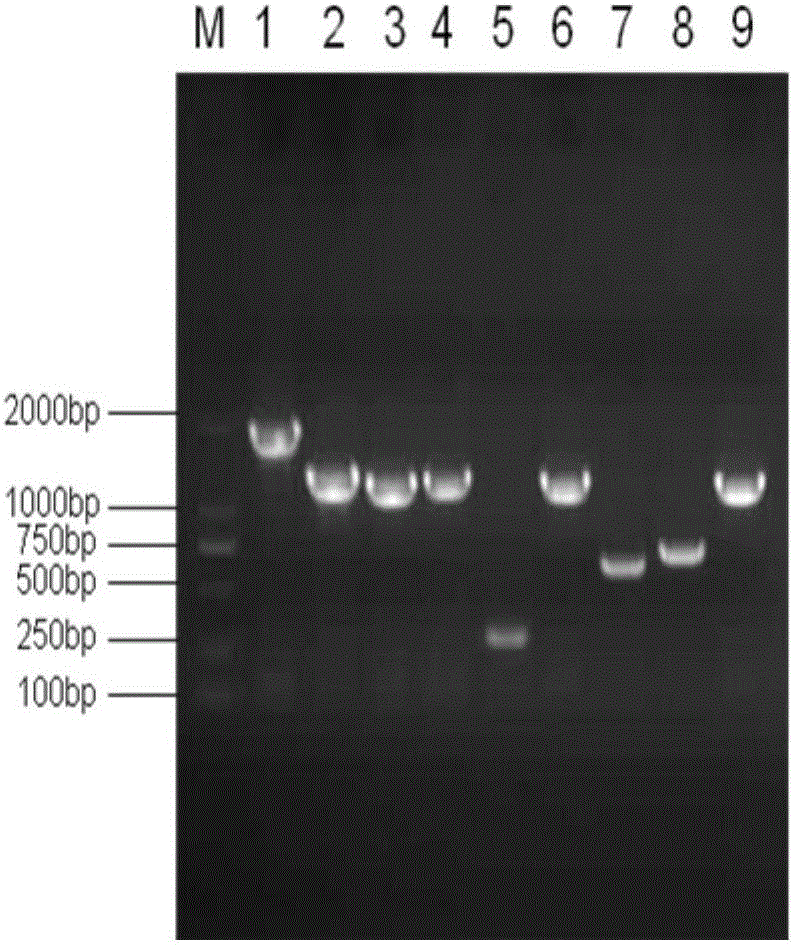Application of heat shock transcription factor 1 in regulating expression of 15kDa selenoprotein
A technology for transcription factor and protein expression, which is applied to the new use of heat shock transcription factor 1, the application field of heat shock transcription factor 1 in regulating the expression of 15kDa selenoprotein
- Summary
- Abstract
- Description
- Claims
- Application Information
AI Technical Summary
Problems solved by technology
Method used
Image
Examples
Embodiment 1、15
[0071] The cloning of embodiment 1,15kDa selenoprotein gene promoter sequence and the determination of core region
[0072] 1. Extraction of Human Genomic DNA
[0073] Genomic DNA was extracted from HEK293T cells by using a DNA extraction kit, the concentration of DNA detected by a nucleic acid protein detector was 0.450 μg / μl, and the value of A260 / A280 was 1.818, and 0.8% agarose gel electrophoresis was carried out as figure 1 shown. It can be seen from the figure that although a small part of the DNA is degraded, the overall quality is good and can be used for subsequent experiments.
[0074] 2. Obtaining fragments of Sep15 promoter by PCR
[0075] Use specific primers to clone 10 segments of the Sep15 gene promoter respectively. The names, sizes and primers of the cloned segments are shown in Table 8. The corresponding positions of the cloned segments on the promoter are shown in Table 8. figure 2 shown. Using the human genomic DNA obtained in step 1 as a template, PC...
Embodiment 2
[0093] Example 2, the promoting effect of overexpressing HSF1 eukaryotic expression vector on the transcription and protein expression of Sep15
[0094] 1. Detection of Sep15 core promoter activity by overexpressing HSF1 eukaryotic expression vector
[0095] After the HEK293T cells were cultured to 80%-90% density, the cells were counted, and 0.5-2×105 cells were plated in a 24-well plate, and the next day, the recombinant pGL4-818 / -248 and pcDNA3.1-HSF1 were co-transfected into HEK293T cells with the pRL-TK plasmid at a ratio of 1:1 (mass ratio), and pcDNA3. 1 / Myc-His A empty vector was used as the control group. After 24 hours of transfection, the cells were lysed and the dual luciferase activity was detected.
[0096] Wherein, the specific construction process of the pcDNA3.1-HSF1 vector is as follows: using the CDS sequence of HSF1 shown in sequence 3 in the artificially synthesized sequence listing as a template, using primers HSF1-MYC-F and HSF1-MYC-R (see Table 4) PCR ...
Embodiment 3
[0104] Example 3. Effect of heat shock on the transcription and protein level of Sep15
[0105] 1. Heat shock detection of Sep15 core promoter activity
[0106] After the HEK293T cells were cultured to 80%-90% density, the cells were counted, and 0.5-2×10 5 Cells were plated in a 24-well plate, and the next day, the recombinant pGL4-818 / -248 and pRL-TK plasmids were co-transfected into HEK293T cells at a ratio of 19:1 (such as 380ng:20ng) to pGL4.10 [LUC2] The empty vector was used as the control. After 24 hours of transfection, heat shock was performed in a water bath at 43°C for 1 hour, and then recovered at 37°C for 4 hours. After that, the cells were lysed for dual-luciferase detection. box instructions.
[0107] The result is as Figure 13 shown. It can be seen from the figure that after heat shock, compared with cells without heat shock, the core promoter activity of Sep15 was significantly up-regulated, indicating that heat shock can significantly increase the core ...
PUM
 Login to View More
Login to View More Abstract
Description
Claims
Application Information
 Login to View More
Login to View More - Generate Ideas
- Intellectual Property
- Life Sciences
- Materials
- Tech Scout
- Unparalleled Data Quality
- Higher Quality Content
- 60% Fewer Hallucinations
Browse by: Latest US Patents, China's latest patents, Technical Efficacy Thesaurus, Application Domain, Technology Topic, Popular Technical Reports.
© 2025 PatSnap. All rights reserved.Legal|Privacy policy|Modern Slavery Act Transparency Statement|Sitemap|About US| Contact US: help@patsnap.com



